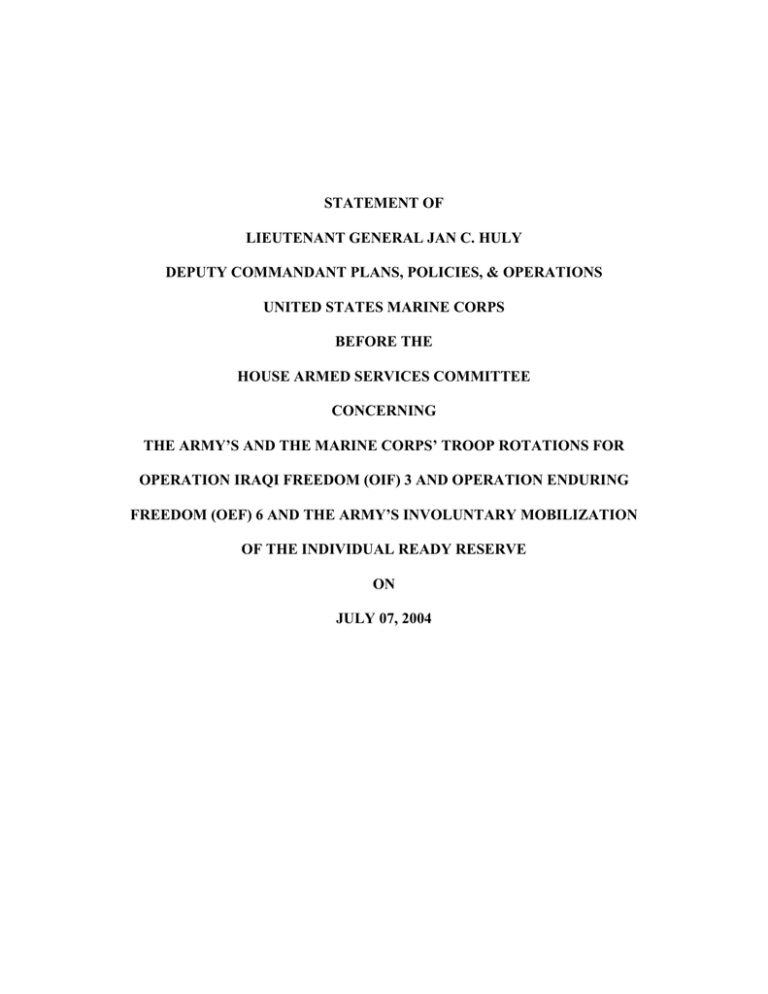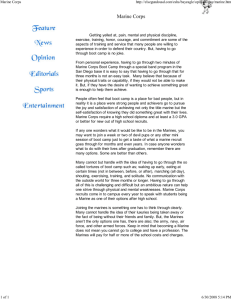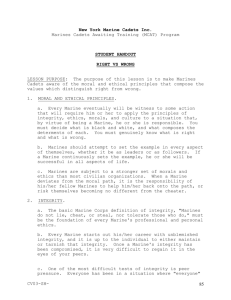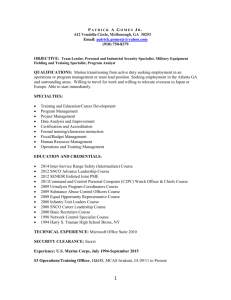STATEMENT OF LIEUTENANT GENERAL JAN C. HULY
advertisement

STATEMENT OF LIEUTENANT GENERAL JAN C. HULY DEPUTY COMMANDANT PLANS, POLICIES, & OPERATIONS UNITED STATES MARINE CORPS BEFORE THE HOUSE ARMED SERVICES COMMITTEE CONCERNING THE ARMY’S AND THE MARINE CORPS’ TROOP ROTATIONS FOR OPERATION IRAQI FREEDOM (OIF) 3 AND OPERATION ENDURING FREEDOM (OEF) 6 AND THE ARMY’S INVOLUNTARY MOBILIZATION OF THE INDIVIDUAL READY RESERVE ON JULY 07, 2004 Introduction Chairman Hunter, Congressman Skelton, distinguished members of the Committee; it is my privilege to report to you on our preparations for troop rotations in support of Operation Iraqi Freedom III (OIF III) and Operation Enduring Freedom VI (OEF VI). On behalf of all Marines and their families, I thank this Committee for your continued support. Current Operations & Status of Forces Today there are over 56 thousand United States Marines forward deployed, based, and stationed worldwide. There are 26,427 Marines in Iraq, 3,942 Marines in Afghanistan, and 657 Marines deployed to the Horn of Africa. Marines are deployed at sea on the warships of Expeditionary Strike Groups and conducting sustained operations ashore in support of U.S. security interests and commitments. Our highest priority is the continued support of OIF II and OEF V, and our preparedness to support troop rotations for OIF III and OEF VI. The Marines of the First Marine Expeditionary Force returned to Iraq early this year to support OIF II, six months after redeploying from OIF I. The Marine force that returned to Iraq was a globally sourced Total Force, carefully designed to ensure the proper warfighting experience level while mitigating high personnel tempo. The same considerations were key to our decision on the duration of troop rotations. The Naval service has a long history of deployment rotations of about six to seven months. For decades our recruiting, assignment, training, shipboard and overseas rotations have been built around this practice. This rotation policy has proven over time to result in the least disruption to the long-term health of the Marine Corps. Marine tactical units (battalion and squadron-sized units) and the Marines that man them in support of OIF II and OEF V deploy in rotations of seven months, and will continue to do so 1 for OIF III and OEF VI. Headquarters, command elements, and the Marines that man them deploy for a period of 12 months. In light of current operational commitments, we believe that this rotation policy remains the best course to provide the combatant commander with the most effective, combat ready units. The policy also minimizes stop-loss/stop-move orders and interruptions in recruit training. It also allows Marines to receive the latest training in their preparation to re-deploy in support of OIF III and OEF VI. Moreover, this policy allows for flexible force applications for other deployment requirements, while retaining the flexibility to extend units without breaking 365 days of “Boots on the Ground.” Manning the Force While the operational tempo remains high, recruiting and retention efforts continue to meet our manpower goals. We are continually monitoring the health of our Service, and we are focused on ensuring that the Marine Corps remains ready to support OIF III and OEF VI. Our Total Force approach to operational commitments plays a key role in the management of Personnel Tempo. Personnel Tempo (Perstempo). As of 30 June 2004, the Marine Corps had 3,379 active component and 1,732 reserve component Marines who have exceeded the 400 out of the preceding 730 days Perstempo threshold. Currently, there are 48,834 active component and 18,855 reserve component Marines who have accrued between 182 and 399 days of Perstempo. Prior to September 2001, the Marine Corps maintained a 2.7:1 unit-level rotation ratio. As a result of the current operational demands associated with the Global War on Terrorism, Marine Corps units are rotating at a 1:1 or higher rate. Nevertheless, to date we have no evidence that the increase in Perstempo has adversely affected retention. We expect that we will continue to 2 meet recruiting and retention goals to keep the force strong through our commitments to OIF III and OEF VI. Recruiting and Retention. The Marine Corps Reserve achieved its Fiscal Year 2003 recruiting goals with the accession of 6,174 Non-Prior Service Marines and 2,663 Prior Service Marines, and our recruiters continue to meet mission goals. Our First Term Alignment Plan (first tour) has achieved its reenlistment requirements for the past nine years. With just over two-thirds of the current Fiscal Year completed, we have achieved 96 percent of our first-term retention goal for the year. Our Subsequent Term Alignment Plan (second tour and beyond) is at 109 percent of our retention goal. Officer retention is at a 19-year high, continuing a four-year trend of increasing retention. However, certain Military Occupational Specialties continue to suffer perennially high attrition. Examples include Explosive Ordnance Disposal technicians, Aviation Electronics Technicians, Electronic Maintenance Technicians, and Public Affairs. Reserves. Our Reserve Marines remain a vital and critical element of our Total Force. Of the 9,801 reservists on active duty as of 30 June this year, 1,391 Individual Mobilization Augmentees, Individual Ready Reserves, and Retirees fill critical joint and internal billets. Reservists will continue to play critical roles in the Total Force plans for OIF III and OEF VI. End Strength. The Marine Corps assimilated last year’s congressionally authorized increase in Marine Corps end-strength to 175,000. The increase of 2,400 Marines authorized by Congress addressed an urgent need to train and maintain enough Marines for the long-term requirements associated with the Global War on Terrorism. We recently completed a Force Structure Working Group study to examine our force structure and manning requirements, and considerations for a possible increase in end strength are under review. Key among these considerations is training support (recruit depot and military occupational school loading), 3 FTAP/STAP supportability, phased increases in officer and enlisted promotions in support of a phased end strength increase, and the infrastructure and funding required to support an increase in manpower. While the force is under stress, our current manning and force rotation policies enable us to plan with confidence to meet the troop rotation requirements for OIF III and OEF VI. Equipping the Force As a result of your support to date, the Marine Corps has had sufficient equipment to support current operations in Iraq and Afghanistan. The readiness of our forces in OIF-II and OEF V continues to be high; currently the overall readiness of operating forces in-theater is 92%. However, aging equipment, high usage rates, and austere conditions in Iraq clearly present future readiness challenges. As an example, our combat vehicles alone (Amphibious Assault Vehicle/ Light Assault Vehicle/ Logistics Vehicle System) are operating at a ratio of combat utilization eleven times that of a normal peacetime rate. Additionally, multiple weapon systems are rapidly approaching the end of their life expectancy. As an example, our Logistics Vehicle System (LVS) with a life expectancy of 20 years when initially fielded, had a pre-OIF age of 18 years on the average. Since the onset of the war, we have incurred several equipment major end item losses (24) due to combat operations, and no “hot production line” exists to replenish such losses. For the LVS, as with other weapons systems, the challenge is exacerbated by the fact that the initial fielding of its replacement is a number of years in the future (FY09 for the LVS Replacement). Mitigation plans do exist, such as the Service Life Extension (SLEP) and Inspect and Repair Only As Necessary (IROAN) programs; however, aging equipment, high usage, and combat losses are affecting our readiness. 4 Combat stress on equipment is an area we are studying closely, and a concern with which we will need your continued support. Maintaining equipment readiness levels through OIF III and OEF VI will necessitate your continued support as our equipment continues to age at a pace that may exceed our ability to repair, refurbish, or replace equipment. As we prepare the force, we will continue to make every effort to pursue modernization and transformation. Maintaining aging “legacy” equipment requires increased financial and manpower investment with each passing year, due to obsolescent parts and higher rates of equipment failure or destruction due to enemy action. With our modernization and transformation goals in mind, we are using the funds provided by Congress to repair, refurbish, and where necessary, replace equipment. To mitigate those challenges noted, the Marine Corps is developing a Total Life Cycle Management tool scheduled for completion later this summer that will compile equipment usage rates and cost factors from our operating forces, program managers, and Marine Corps Logistics Command into a comprehensive document to better assess the costs of OIF III and OEF VI operations, and to determine the most efficient and cost effective manner to either repair or replace our equipment. Additionally, we have formed a Strategic Equipment Working Group that is tasked to work with the operating forces to formulate overall sourcing practices related to all Marine Corps requirements to include current and future OIF III and OEF VI obligations. Maritime Prepositioning Force Program. It will take time to return the Maritime Prepositioning Force program to pre-OIF employment capability, and the use of Maritime Prepositioning Squadron assets in support of OIF II may extend reconstitution. One squadron is complete and ready to respond to any contingency. Several ships in the other two squadrons had completed reconstitution, but those ships have since been used to support the Marine forces 5 deploying for OIF II. The current schedule has one Maritime Prepositioning Squadron completing its scheduled maintenance cycle in April 2005, and the second squadron concluding its scheduled maintenance cycle in April 2006. The time it will take until we have all three squadrons back up will be a function of additional equipment requirements in support of OIF III and OEF VI, Corps-wide equipment readiness, and the condition of the equipment that returns from OIF II. Reconstitution of our forces and Maritime Prepositioning Squadrons will be a challenge for the foreseeable future. Conclusion In conclusion, I would like to again thank the members of this Committee for your continuing support of the Marine Corps. The young men and women of your Corps are doing an exceptional job and will continue to do so through OIF III and OEF VI. Their accomplishments are a direct reflection of your continued commitment to maintaining our Nation’s expeditionary warfighting capability. We go forward with confidence because Marines have the best training and equipment in the world, thanks to this Congress, and the Nation we proudly serve. 6







